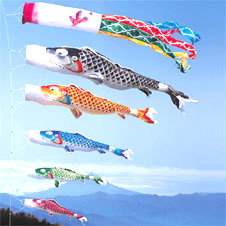Japanese Tradition Of Fish Flags
|
According to the Japanese legends the Japanese tradition of fish flags originates actually from a Chinese legend. According to this legend the carp that could swim up against the current in the Yellow River would end up becoming a dragon. |
In Japan, the carp (or Koi as it is known is Japanese) is a symbol of perseverance in the face of adversity. It is the symbol of strength and determination to overcome obstacles and attain high goals.
Basically, the Japanese fish flag stands for worldly aspirations and advancement in life. For others, it is a symbol of good fortune and luck.
Here are some more facts on Koi and Japanese tradition of fish flags:
- The Koi is symbolic in Buddhist religion. Just like a fish swimming through water, humans swim through the ocean of suffering without fear.
- The fish flag is symbolic in a family and on Children’s Day in Japan, these flags are flown in all homes. Black fish flags are for fathers, orange/red for mothers, blue/white for boys and red/pink for girls. Earlier in Japan, May 5th was initially celebrated as Boy’s Day and the Girl’s Day was on March 3rd. Today, Children’s Day is celebrated in the first week of May, which is referred to as the Golden Week. During this period, Japanese companies are closed for a week and people use this occasion to travel either in Japan or overseas. The Children’s Day is now known as Kodomo No Hi.
- You will find as many as 5 golden Koi flags being flown on many homes. The flying of these flags symbolizes and represents wealth and well-being.
- Basically Koi is associated with good luck and that is why the Japanese traditional fish flags can be of any color and size.
More Articles :

|
